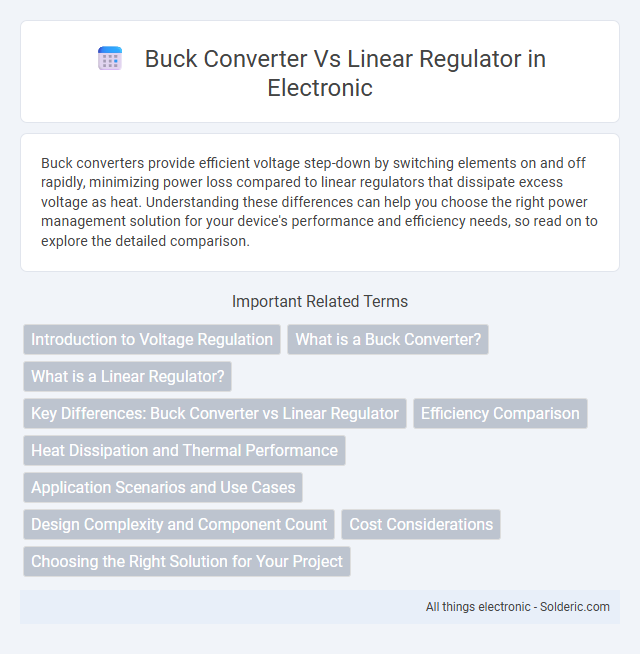Buck converters provide efficient voltage step-down by switching elements on and off rapidly, minimizing power loss compared to linear regulators that dissipate excess voltage as heat. Understanding these differences can help you choose the right power management solution for your device's performance and efficiency needs, so read on to explore the detailed comparison.
Comparison Table
| Feature | Buck Converter | Linear Regulator |
|---|---|---|
| Efficiency | High (80%-95%) | Low (30%-60%) |
| Heat Dissipation | Low | High |
| Input Voltage Range | Wide | Narrow (Vin must be higher than Vout) |
| Output Noise | Higher (switching noise) | Low (clean output) |
| Complexity | High (inductors, capacitors, switching elements) | Low (simple design, fewer components) |
| Cost | Higher | Lower |
| Size | Larger (due to external components) | Smaller |
| Applications | Power-sensitive devices, battery-powered systems | Low-noise applications, simple voltage regulation |
Introduction to Voltage Regulation
Buck converters efficiently step down voltage by switching elements on and off rapidly, making them ideal for high power applications with excellent energy efficiency. Linear regulators provide a simpler method by dissipating excess voltage as heat, suitable for low noise requirements and lower power scenarios. Understanding your power supply needs helps determine if a buck converter's efficiency or a linear regulator's simplicity best suits your voltage regulation tasks.
What is a Buck Converter?
A buck converter is a type of DC-DC power converter designed to step down voltage efficiently by switching elements like transistors and inductors at high frequency. It offers higher energy efficiency compared to linear regulators by minimizing power dissipation through rapidly switching between on and off states. Your power supply design benefits from reduced heat generation and longer battery life when using a buck converter.
What is a Linear Regulator?
A linear regulator is a power supply device that maintains a constant output voltage by dissipating excess input voltage as heat, making it simple and low-noise but less efficient for large voltage drops. It operates by operating a transistor in its active region to drop voltage and regulate current, ideal for low power applications requiring minimal ripple and noise. Unlike buck converters, linear regulators lack switching components, resulting in straightforward design but higher power loss at higher voltage differentials.
Key Differences: Buck Converter vs Linear Regulator
Buck converters are switching regulators that efficiently step down voltage with higher power efficiency, typically 80-95%, by rapidly switching their internal transistors and using an inductor to store and transfer energy. Linear regulators, in contrast, provide a simpler, low-noise voltage regulation by dissipating excess voltage as heat, resulting in lower efficiency, often below 50%, especially with significant voltage drops and high current loads. Buck converters generate more electromagnetic interference (EMI) due to high-frequency switching, whereas linear regulators excel in applications requiring low noise and minimal ripple for sensitive analog or RF circuits.
Efficiency Comparison
Buck converters deliver efficiency levels typically between 80% to 95% by switching power components rapidly, minimizing energy loss during voltage step-down. Linear regulators often operate at efficiencies below 50%, as they dissipate excess voltage as heat, especially under large voltage drops. Selecting a buck converter is ideal for power-sensitive applications requiring high efficiency and minimal heat generation.
Heat Dissipation and Thermal Performance
Buck converters generate significantly less heat compared to linear regulators due to their high efficiency in converting voltage, often exceeding 85-95%, which minimizes power loss as heat. Linear regulators dissipate excess voltage as heat, making them less suitable for applications with large input-to-output voltage differences and high current demands. Optimizing your power supply choice for thermal performance involves selecting buck converters for efficient heat management and improved thermal reliability in compact electronic designs.
Application Scenarios and Use Cases
Buck converters are ideal for applications requiring high efficiency and significant voltage step-down, such as powering microcontrollers, RF modules, and battery-powered devices in portable electronics. Linear regulators are preferred in low-noise, low-dropout scenarios like audio equipment, sensitive analog circuits, and low-power sensors where simplicity and minimal electromagnetic interference are critical. Industrial automation and embedded systems often leverage buck converters for energy-efficient power management, while linear regulators suit precision regulation needs in instruments and communication devices.
Design Complexity and Component Count
Buck converters feature higher design complexity and require more components such as inductors, capacitors, diodes, and switching transistors compared to linear regulators, which utilize fewer passive elements and simpler circuitry. The complexity of buck converters stems from their need for precise switching control and feedback loops to maintain efficient voltage regulation. In contrast, linear regulators provide straightforward design and minimal component count but trade off efficiency for simplicity.
Cost Considerations
Buck converters typically offer higher efficiency and reduced heat dissipation compared to linear regulators, resulting in lower energy costs over time despite their higher initial component price. Linear regulators have simpler designs and lower upfront costs but waste more power as heat, increasing cooling requirements and operational expenses. In applications where power efficiency and long-term cost savings are critical, buck converters present a more cost-effective solution despite complexity and initial investment.
Choosing the Right Solution for Your Project
Buck converters offer higher efficiency by stepping down voltage with minimal power loss, making them ideal for battery-powered and heat-sensitive applications. Linear regulators provide simpler design and lower noise output, preferred in low-dropout situations and noise-sensitive analog circuits. Selecting the right solution depends on power efficiency requirements, thermal constraints, complexity tolerance, and output noise sensitivity in your project.
buck converter vs linear regulator Infographic

 solderic.com
solderic.com